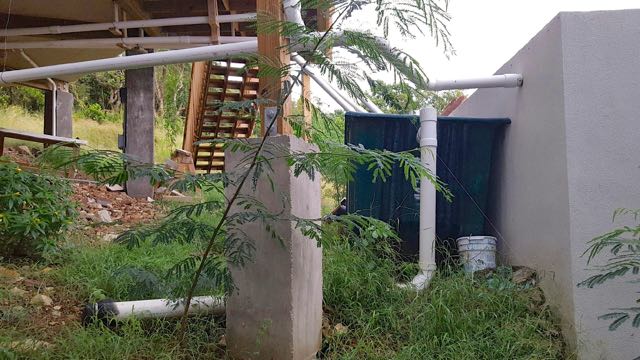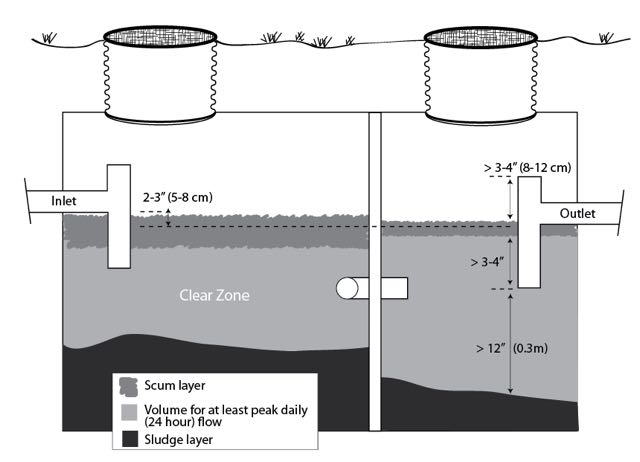
Wastewater runoff is a mounting issue in the Virgin Islands as more and more development takes place along shorelines and existing wastewater systems deteriorate.
Improperly built wastewater treatment systems are a significant contributor to water pollution in the territory and many of them illegally surface-discharge poorly treated water on the properties they serve. When it rains, that polluted wastewater contaminates other surface water resources by getting into guts and then flushing out to the territory’s bays.
There are a number of issues that contribute to this pollution, including a lack of regulatory oversight and education. But if the territory wants to preserve environmental and human health – both of which are tied to the tourism economy – then it must work to reform the regulatory system and educate property owners on the harm these faulty systems can cause – as well as how to correct those problems.
To get a full grasp of the wastewater runoff issue as it relates to decentralized wastewater systems, the Source spoke to government employees, environmental scientists and wastewater industry professionals, including engineers and plumbers.
Onsite wastewater treatment systems
Approximately 30 to 35 percent of the territory’s residential, commercial and industrial areas are connected to public sewers. That means about 70 percent of properties in the Virgin Islands dispose of sewage through onsite disposal systems, which are commonly referred to as septic systems. These systems vary widely in type and size, ranging from single-family residences to large shoreline resorts and other commercial facilities.
According to a number of the territory’s environmental scientists and wastewater system industry professionals, there are many onsite systems that have been improperly built that are contributing to water pollution by not effectively treating for nitrogen, phosphorous and pathogens – the last of which is what causes beach advisories that recommend against swimming at a beach until it flushes out.
Enterococci bacterial testing is used as an indicator of the likely presence of harmful pathogens in those waters.
Speaking on behalf of Norman Williams, director of the Department of Planning and Natural Resources’ Division of Environmental Protection, and his team earlier this year, Jamal Nielsen, DPNR media relations coordinator, said it’s difficult to say what percentage of systems are properly built.
“If it is not properly built, then it did not go through our offices or review process so DPNR would not know about it and will not have a number we can calculate,” Nielsen explained. “We have discovered unpermitted systems through investigation of public complaints.”
Nielsen continued, “An improperly installed system, as mentioned above, would mean the design of the system was either not reviewed or that the system was not inspected by regulatory entities prior to being installed.”
A general building permit from the Division of Building Permits is required for constructing a new decentralized wastewater system and requires showing design drawings for approval. But if the property owners didn’t pull a building permit, there’s no way of keeping track of the new systems.
“The most difficult part is finding all the violators that did not go through the proper review and approval process at DPNR. Most systems that are illegally built will not operate properly and will eventually fail,” said Nielsen, adding that DPNR needs the community’s help to track down all the faulty systems.
Unregulated surface discharge harms water quality
According to DPNR, if a wastewater system discharges to the ground surface or into the waters of the Virgin Islands it requires a Territorial Pollutant Discharge Elimination System (TPDES) permit, which are issued for the life of the system and are renewed every five years.
Scientists and wastewater experts say there are hundreds of systems, some small and some large, that should be required to have TPDES permits because they are surface discharging.
Permitted systems require regular monitoring and water sampling to ensure that the treatment meets V.I. Water Quality Standards. The results of these discharged water quality tests are then reported to DPNR and the EPA on a scheduled basis through documents called Discharge Monitoring Reports (DMR).
That’s the regulatory process that’s been setup to ensure that what comes out of the wastewater system won’t harm human or environmental health. The DMR database records track publicly and privately owned wastewater systems that have surface discharge permits.
But local industry professionals report that many properties are surface discharging even though they don’t have a TPDES permit. That means there’s no follow-up monitoring, inspection or water-quality monitoring happening, which is illegal.
These TPDES permits are required for residences that release wastewater on the property through a point release like through the end of a pipe or through sprinkler heads for watering yards. But many people are unaware of this requirement and their wastewater is not being treated enough despite its potential to contaminate surface waters.
One plumber on St. Thomas has reported seeing many septic systems that have a vent pipe just before their septic tank that is left uncapped, so if their system fails it won’t back up in their showers. That configuration is illegal, since it can lead to raw sewage being released in yards.
Industry experts have said that that septic systems are supposed to be sized according to soil type and household size, but many systems are undersized and can’t handle the amount of waste being put into them. And drainage fields are also most often much smaller than is needed.
The Department of Planning and Natural Resources, not the building permit office, is responsible for reviewing the design plans of each treatment system. Not every plan is reviewed, though, since DPNR reportedly lacks the manpower to review all of them and the building permit office doesn’t always notify department when there is a new construction.
Then there’s the issue of moonlighting.
According to industry professionals who have witnessed it firsthand, there have been instances of DPNR staff being hired to design a residential wastewater system even though they are in the department that should be doing the inspections on them. In short, the designer should not also be the inspector; nor should they be responsible for reviewing design plans on behalf of DPNR.
To design and build properly functioning systems, industry experts say DPNR needs to hire enough people with the appropriate technical background and experience to conduct credible reviews. They’ve said that DPNR should conduct inspections during and at the completion of construction to ensure that what’s on those permitted plans is what’s put in the ground.
Improving onsite wastewater systems
Addressing wastewater runoff issues is a large task but it can be done. It would require individual homeowners modifying existing onsite wastewater systems and DPNR making sure new systems are designed and built correctly.
According to industry experts, sustainable onsite wastewater treatment systems should be suited to the site and its natural conditions, so that public and environmental health will be protected.
Susan Parten, a licensed professional civil-environmental engineer who practices in both the Virgin Islands and Texas and has more 30 years of experience in this area of engineering, said systems should not be allowed to release wastewater onto the ground surface unless DPNR issues a TPDES permit.
Regular monitoring and reporting required under the TPDES program is critical to ensuring that water is safe enough to discharge on the ground surface. These regulations apply to both residential and larger scale systems like resorts and hotels.
Parten said that even though much of the land area in Virgin Islands is steep and rocky, there is still an adequate amount of soil to absorb wastewater in most places, unless vegetation has been removed from the hillsides and erosion has been allowed to occur.
“We need to have properly sized and configured systems for flows and site conditions that employ subsurface soil dispersal of the treated water, so as to allow natural soil conditions and vegetation to uptake nutrients and break down pollutants and prevent those pollutants from entering our waters,” Parten said.
That can be accomplished by placing subsurface dispersal areas behind retaining walls on steep sites, so the phosphorous, nitrogen and other pollutants can have the space and residence time in the soil to be handled properly. Retaining walls also serve to keep soils on our hillsides and out of shoreline waters.
“For surface runoff pollutant control, we need to terrace our properties and build retaining walls, behind which we have vegetated infiltration capabilities,” Parten explained. Ancient civilizations routinely used this approach for creating usable areas for a variety of activities, including farming.
Nitrogen and phosphorous are regulated across the United States, since these nutrients can cause algae blooms and harm marine life, but only phosphorous is regulated in the Virgin Islands. Water quality standards for nitrogen are being set now and will go into effect in 2018 at the earliest.
Areas in the U.S. such as the Chesapeake Bay have adopted nitrogen limits and acceptable approaches for onsite decentralized wastewater systems. Those nitrogen control limits and guidelines could be adopted on an interim basis to begin addressing the territory’s problems immediately.
Adopting temporary nitrogen limits before 2018 is also important, Parten said. The new rule is still a couple years away at least, but corals are struggling now and pollutants make it more difficult for them to bounce back from bleaching events, which is concerning given warming events are on the rise, she said.
The world is entering its third straight year of global coral bleaching – the longest ever to date – and limiting other manmade stressors like pollutants from getting into the territory’s waters can increase the likelihood of corals surviving.
“We desperately need to reestablish that sense of pride and protection for quality of life and resources in the Virgin Islands,” Parten said. “Healthy marine ecosystems and shorelines are the life blood of these islands.”






